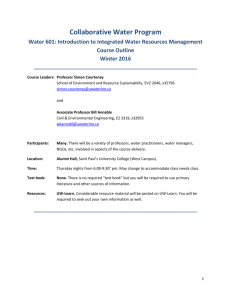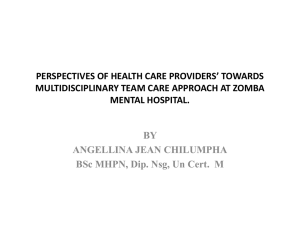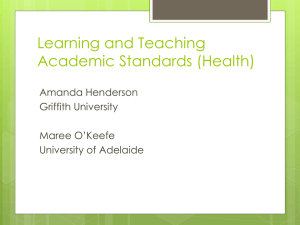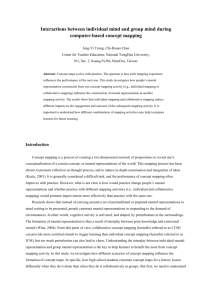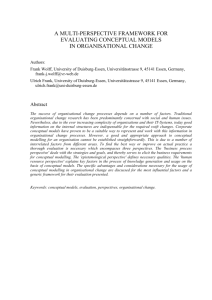UGEC-2 Synthesis - International Council for Science
advertisement
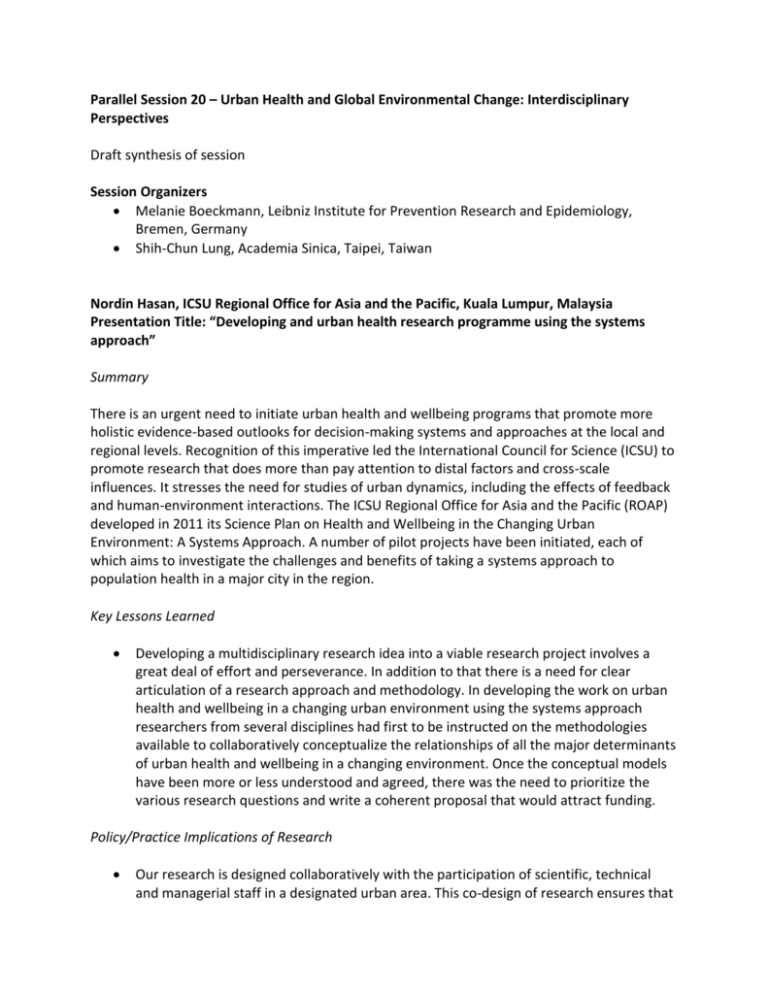
Parallel Session 20 – Urban Health and Global Environmental Change: Interdisciplinary Perspectives Draft synthesis of session Session Organizers Melanie Boeckmann, Leibniz Institute for Prevention Research and Epidemiology, Bremen, Germany Shih-Chun Lung, Academia Sinica, Taipei, Taiwan Nordin Hasan, ICSU Regional Office for Asia and the Pacific, Kuala Lumpur, Malaysia Presentation Title: “Developing and urban health research programme using the systems approach” Summary There is an urgent need to initiate urban health and wellbeing programs that promote more holistic evidence-based outlooks for decision-making systems and approaches at the local and regional levels. Recognition of this imperative led the International Council for Science (ICSU) to promote research that does more than pay attention to distal factors and cross-scale influences. It stresses the need for studies of urban dynamics, including the effects of feedback and human-environment interactions. The ICSU Regional Office for Asia and the Pacific (ROAP) developed in 2011 its Science Plan on Health and Wellbeing in the Changing Urban Environment: A Systems Approach. A number of pilot projects have been initiated, each of which aims to investigate the challenges and benefits of taking a systems approach to population health in a major city in the region. Key Lessons Learned Developing a multidisciplinary research idea into a viable research project involves a great deal of effort and perseverance. In addition to that there is a need for clear articulation of a research approach and methodology. In developing the work on urban health and wellbeing in a changing urban environment using the systems approach researchers from several disciplines had first to be instructed on the methodologies available to collaboratively conceptualize the relationships of all the major determinants of urban health and wellbeing in a changing environment. Once the conceptual models have been more or less understood and agreed, there was the need to prioritize the various research questions and write a coherent proposal that would attract funding. Policy/Practice Implications of Research Our research is designed collaboratively with the participation of scientific, technical and managerial staff in a designated urban area. This co-design of research ensures that the science questions posed in the project will produce answers that can be applied to urban policy-makers and managers. Policy relevance of the research in ensured because the design is collaborative and the scientists in the research teams understands the need to be policy and practice-relevant. The institutional challenge is to ensure the participation of city managers in scientific research design, and that the findings of the research is implemented even if it means overturning earlier decisions or replacing old policies with newly redesigned policies. Knowledge Gaps and Needs There are methodological knowledge gaps and research groups engaged in the codesign of multidisciplinary collaborative research needs to participate in capacity building workshop to understand the systems approach that we use. The tendency for established research groups/teams is to do more of the same using methods they have been used to. When a multidisciplinary approach is adopted there will also be the need to learn new ways of analyzing data from multiple disciplines. Quantitative methods in one field may not be applicable in another and new ways may have to be found to integrate data or information from several different fields. Shih-Chun Lung, Academia Sinica, Taipei, Taiwan Presentation Title: “Using a systems approach to design a green transportation system for better urban health under climate change” Summary The main focus of this presentation is to present a cross-disciplinary integrated research framework of using a systems approach linking transportation, air quality (and climate) and urban health. Different green transportation alternatives have various degrees of transportation function. To tackle the challenge of complexity among different sectors, the emphasis is placed on the feedback loops among green transportation, air quality, climate, and urban health, according to collaborative conceptual modelling (CCM). A conceptual tool kit is constructed to provide interrelationships among different sectors. This presentation uses Taiwan as an example to showcase the conceptual tool kit. Key Lessons Learned The systems approach is a key methodology that can be used in multidisciplinary works such as linking the research of health-related issues to global environmental change studies and urban planning. The essential lesson learned from this work is to demonstrate the importance of using such a methodology to streamline modeling works in different disciplines at the research planning stage to ensure the successful delivery of research outcomes in each discipline as well as an integrated research output useful to tackling challenges in current urban planning. Policy/Practice Implications of Research It is important for policy-makers to visualize the potential benefits among different policy choices before making decisions. In this work, a conceptual tool kit is constructed to provide relationships among different sectors in transportation, air quality, and urban health. Decision-makers can be better informed of the potential co-benefits of green transportation alternatives with respect to environmental impacts and health risks under current and future climate change scenarios. Actions then can be taken to formulate plans for future transportation infrastructure that would lead to better urban health under climate change. Knowledge Gaps and Needs We need more research on using a systems approach to connect different disciplines and further link with decision-making processes. Doing multidisciplinary research is challenging since different disciplines have their own jargon. Collaborative Conceptual Modelling (CCM) has the potential to focus on the overlapping linkages among different disciplines with a common language, and leave the discipline jargon within their own research field. We need to promote the usage of CCM in order to facilitate transdisciplinary research under Future Earth. Katrina Proust, The Australian National University, Canberra, Australia Presentation Title: “History and the feedback dynamics of technology choice” Summary This study provides an example of the use of Collaborative Conceptual Modelling (CCM). It demonstrates how techniques from the practice of history can reveal important aspects of feedback dynamics. Installing air conditioning immediately allows people to control their living environment. Hence, communities have been able to inhabit areas of extreme temperature and humidity that would be otherwise unsuitable for permanent settlements. But this dependence results in a loss of adaptive capacity. The use of air conditioning in domestic dwellings reduces an individual’s ability to acclimatize to temperature and humidity changes. When serious heatwaves occur, and dependence on air conditioning is highest; the power-generating system is stretched to capacity. This situation increases the risk of power failures, and the number of cases of thermal stress in the community. It has important implications for climate-change adaptation in urban settings. Key Lessons Learned Historical studies can provide dynamically relevant data to support system analysis. Such studies are essential in attempts to see strings of events as evolving patterns. We live in a world dominated by feedback where urban systems are becoming more complex. We need to be alert to feedback effects, especially cross-sector feedback. Policy/Practice Implications of Research The unintended outcomes of urban policy are usually delayed and unwanted. Because they are delayed, these outcomes are often erroneously attributed to proximal events. To anticipate unwanted outcomes, urban policymakers need to imagine a much wider system with its many links. Historical-dynamical studies can help to understand systems better and to reduce policy surprise. Key Discussion Points Systems dynamics is good for modelling a physical system, but not very precise for modelling social and economic systems. Urban planners can and should play an important part in improving health in cities. Co-production and co-design of knowledge will require all sides to compromise and open lines of communication outside their element. System archetypes are structures that frequently occur in system and that have direct correlation with human behavior. They are often symptoms of deeper behaviors and are numerous in example.
